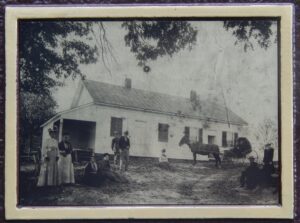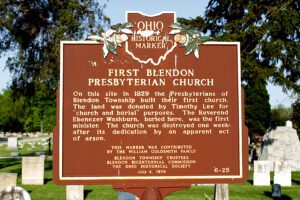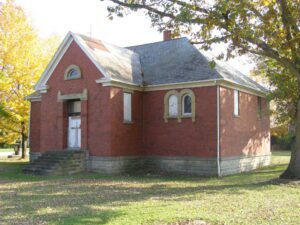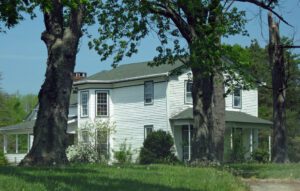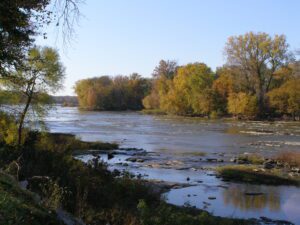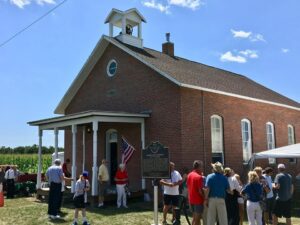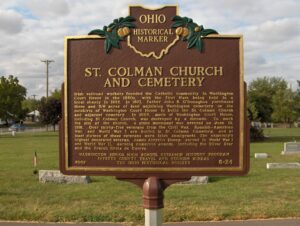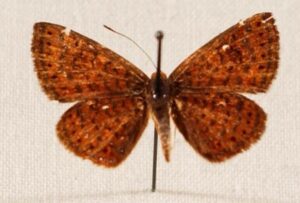, OH
Congregations of the Religious Society of Friends (Quakers), called “meetings”, worshiped in plain meeting houses. On this site stood the last Richland Friends Meeting House, built in 1872. Ninety-four Friends established the meeting in 1826 and it endured for 147 years. The cemetery is where many generations of members of this meeting are buried. The faith, based on pacifism and simplicity, blossomed in the region during the first half of the 19th century. (Continued on other side)
, OH
On this site in 1829 the Presbyterians of Blendon Township built their first church. The land was donated by Timothy Lee for “church and burial” purposes. The Reverend Ebenezer Washburn, buried here, was the first minister. The church was destroyed one week after its dedication by an apparent act of arson.
, OH
This Little Red Schoolhouse served children from Berea, Brookpark, and Middleburg township. The first mayor and council of Middleburgh Heights were elected here. During its colorful history, the schoolhouse has been a City Hall where town meetings were held, a speak-easy, a railroad way station, and a private residence.
, OH
Betsey Mix Cowles dedicated her life to fighting slavery and improving the status of women. Her desire for a formal education led her to Oberlin College, where she completed two years of study in 1840. An advocate of immediate abolition, Cowles lectured on the moral depravity of slavery, opened her home, at this site, to fugitive slaves. Opposed to expansion of slavery into the West, Cowles protested the Mexican War. Cowles served as president of Ohio’s first women’s rights convention (in Salem) in 1850, and the following year wrote a treatise on equal pay for working urban women. She served as the first dean of women at Grand River Institute, and later became one of the first women public school superintendents in Ohio.
, OH
This site, at the head of the Great Rapids of the Maumee, has been a major river crossing for centuries. The village was platted in 1833 as Gilead but was overshadowed by rival Providence during the canal era. In 1868 the name Grand Rapids was adopted, and the town prospered with the arrival of the railroad in 1877. Fires ravished the village in the late 1890s and spring floods have remained a threat. Restoration of the Victorian architecture began in 1975 and has helped revitalize this village along the historic Maumee.
, OH
Bridenbaugh District No. 3 School. One-room schools were commonly named for people who furnished land for the building. Michael Bridenbaugh (1820-1895), who settled in Riley Township in 1835, and wife Jemima (1834-1903) sold a half-acre of land to the Riley Township school board in 1873. The first school on the site was a wooden structure, built in 1878. It was replaced by a brick building in 1889. The school operated until 1927, after which the district was consolidated. Students attended classes in nearby Pandora. (Continued on the other side)
, OH
Irish railroad workers founded the Catholic community in Washington Court House in the 1850s, with the first Mass being held in a local shanty in 1852. In 1871, Father John B. O’Donoghue purchased three and 5/8 acres of land adjoining Washington cemetery on the outskirts of Washington Court House to build the St. Colman Church and adjacent cemetery. In 1885, much of Washington Court House, including St. Colman Church, was destroyed by a tornado. To mark the site of the church, a stone monument was erected on June 19, 1916. Over thirty-five veterans from the Civil War, Spanish-American War, and World War I are buried in St. Colman Cemetery, and at least sixteen of these veterans were Irish immigrants. The cemetery’s highest decorated veteran, James Aloysius Ducey, served in World War I and World War II, earning numerous awards, including the Silver Star and the French Croix de Guerre.
, OH
In 1942 Cedar Bog became the first nature preserve in Ohio purchased with state funds. Efforts to set this wetland aside began in the 1920s through the efforts of Florence Murdock and her daughter. Efforts intensified in the mid 1930s with help from Walter Brigham Evens, Jr., and finally came to fruition in 1941 due to the interests of Champaign County Common Pleas Judge Owens, Governor John Bicker, and Dr. Edward S. Thomas of the Ohio Historical Society. This relatively small parcel is an outstanding example of a prairie/fen complex known as Cedar Swamp that once covered 7,000 acres of the Mad River Valley. Approximately one quarter of the plant species in Ohio are found here. Cedar Bog also has a large number of rare species, two of which, the Small Yellow Lady’s Slipper Orchid and Prairie Valerian, occur in Ohio only at Cedar Bog or one other site.


